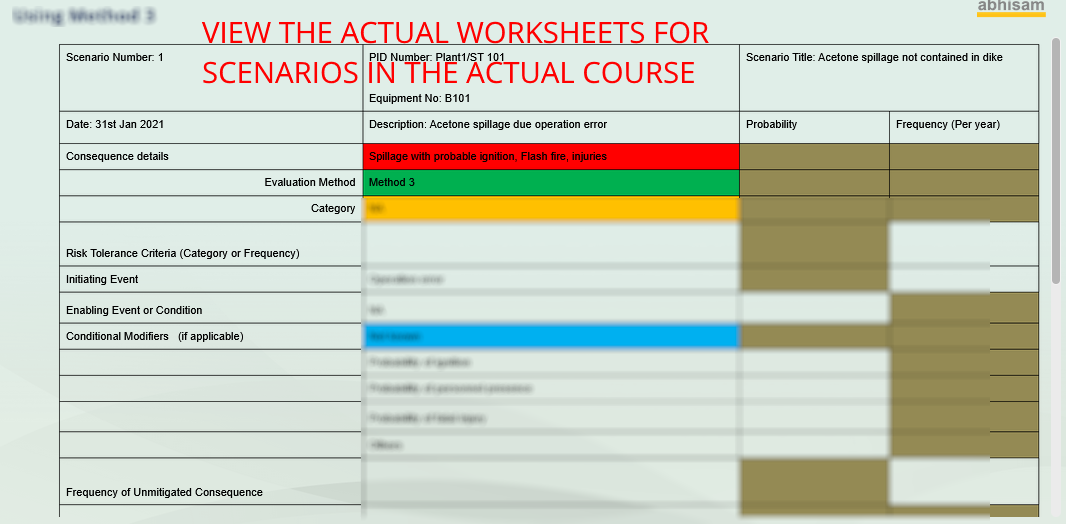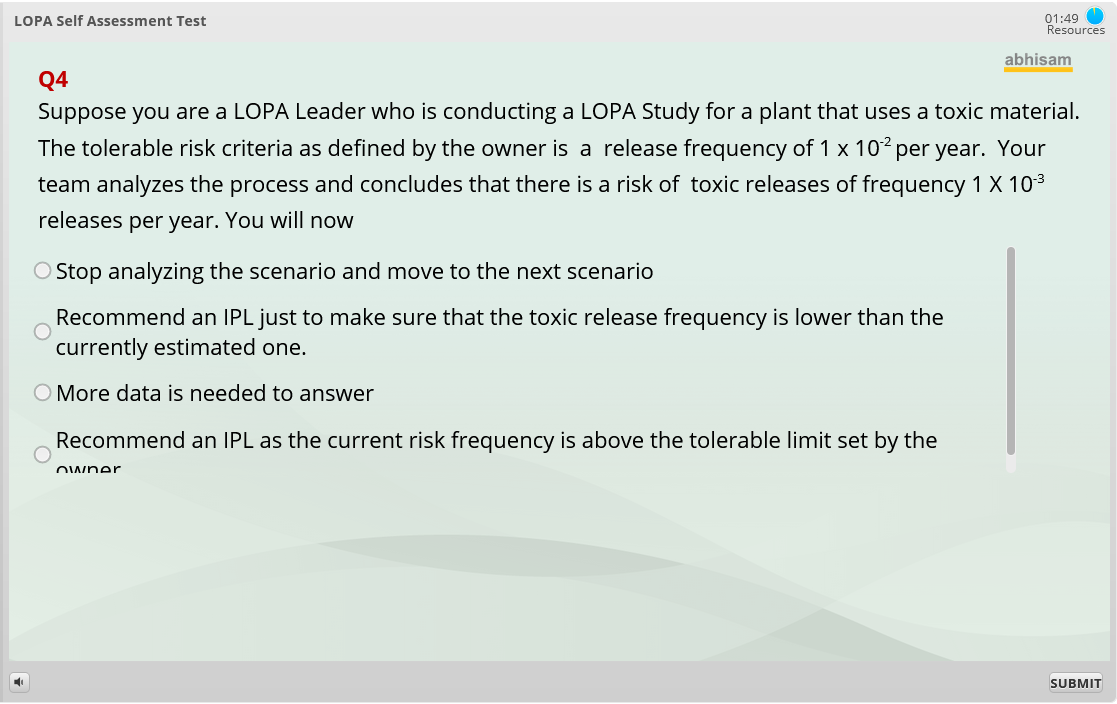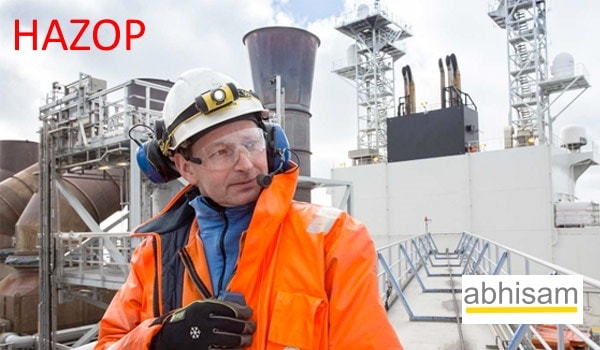Layer of Protection Analysis Training and Certification
Learn all about Layer of Protection Analysis in this easy online LOPA Course from Abhisam and get certified as a certified LOPA Professional.
Easy learning via real life examples, videos, animations, graphics and exercises. This is not a PPT or a video of a guy speaking into the camera.
Take this easy online Layer of Protection Analysis training course from Abhisam and qualify as a LOPA Professional when you pass the associated exam.
LOPA is a well accepted technique used in Hazard and Risk Assessment. It is considered to be one of the best semi-quantitative techniques, that can give you an order of magnitude estimate of the risk potential of your plant or facility for different scenarios. Further it also aids in building Independent Protection Layers (IPLs) to reduce the initial risk to a tolerable value.
Key Benefits of the Course
- Self Paced Course, learn at your own speed, whenever you wish.
- A Rich learning experience having videos, animations, simulations, exercises and more to engage your interest. Its not a video of a guy talking to the camera!
- Worked examples and calculations using real life examples and worksheets
- Learn from home, office or anywhere else.
- Access from any device PC/laptop/Mac/Tablet-no restrictions.
- Includes Online Exam and Certification.
- Prove your competency by displaying your electronic badge online on social media.
Course Modules
This is the most comprehensive LOPA Training course that you can find anywhere.
The subject is covered in detail in 12 modules, followed by a Self Assessment Test.
You can take the associated exam after you complete all the modules and the test. On passing the exam, earn a Certificate of Competency and an Electronic Badge of Certified LOPA Professional.
- Module 1-Hazards, Risks & Risk Assessment.
- Module 2-Introduction to Layer of Protection Analysis (LOPA).
- Module 3-LOPA methodology.
- Module 4-Process Hazard Analysis (PHA)
- Module 5-Estimating Consequences and Severity.
- Module 6-Identifying and developing a scenario.
- Module 7-Identifying the initiating Event and determining the frequency.
- Module 8-Identifying independent Protection Layers (IPLs)
- Module 9-Estimating the Risk of the Scenario.
- Module 10-Evaluating the risk for decisions.
- Module 11-Risk Reduction Measures
- Module 12-LOPA Closing Session & LOPA Report
- Self-Assessment Test
Get Certified as a LOPA Professional! Earn an electronic badge that you can display online.


Customer Feedback
“I have worked in the International Oil and Gas Industry as a technical instructor for more than thirty years. I have both used and recommended the products of Abhisam. I recommend them highly to all engineers and technicians in our industry. No praise is too great!!
John Longden
GCGI LCGI. Senior Trainer
Petroleum Training Institute, UK“
“I work as an independent HSE consultant. I have attended several training courses on PHA, Process Safety and LOPA by various training providers in the past. However this Abhisam LOPA course is by far the best one that I took. It is self-paced and easily accessible. The structure and flow of the course makes this complex subject, interesting and easy to understand. I would recommend this course to anybody who wants to learn LOPA.
R. Shivakumar, Independent HSE Consultant, KUWAIT
Who takes Abhisam Courses?
Technical professionals in marquee international organizations, independent consultants, contractors, employees of government organizations, take Abhisam courses to learn new skills and earn certifications.





Click the Title Links below to see the features
Get real world experience of analyzing Scenarios from real life plants and facilities. The course steps you through multiple scenarios using multiple LOPA Methods.

Simulated videos to help you understand how LOPA Studies are carried out in practice. (Only a small clipping is shown as an example. Get the full videos in the course).
The included self assessment test enables you to understand your own level of knowledge about the topic and helps in preparing for the Certification exam.
Here’s a sample question from the test.
Real Life Case Study Included
A real life case study of a LOPA Study project is included and each module steps you through this case study as it progresses further as the scenario gets developed. It will have
- Situational videos so that you learn how LOPA sessions look like in practice
- Actual worksheets for each scenario, so that you can see how the scenario gets developed from the initial PHA to the final LOPA Report.
- You can use these worksheet formats in similar scenarios in your own work.
Choose from any of the versions.
Scroll below to see complete contents of the course.
Standard
For one learner-
Course Duration: 60 hours of self paced learning (Earn 60 PDH)
-
Access the course online 24/7 via any device for one year
-
Exam & Certification for one learner
-
Lifelong Valid Certificate
Professional
For one learner-
Everything in Standard plus
-
Access the course for 3 years
Get Trial Access to all Abhisam courses, including this Layer of Protection Analysis course for $7.
You will NOT be billed automatically after trial ends.
Table of Contents can be viewed here.
Please click the + sign to see the detailed contents of each module
- Welcome
- Introduction to Module -1
- Introduction to Hazards & Risks
- Comparison of Risks
- Risks in the Process Industries
- Risks in the Nuclear Industry
- Hazards in the Workplace
- Risk Assessment
- Risk Reduction & LOPA
- Designing the Layers
- Risk Assessment Example-1
- Risk Assessment
- Risk Reduction
- Risk Measurement
- Risk Reduction Process
- Risk Reduction Stages
- Risk Assessment is Iterative
- How much Risk Reduction is enough?
- ALARP Concept
- Beyond ALARP
- Types of Risk Assessment Techniques
- Semi-Quantitative & Quantitative
- Techniques of Risk Assessment
- Qualitative Risk Assessment Methods
- Qualitative Studies
- Semi-quantitative Risk Assessment methods
- Semi-quantitative Studies
- Quantitative Risk Assessment methods
- Quantitative Studies
- Thank You
- Welcome
- Introduction
- Manufacturing Plants
- Process Activities in manufacturing
- Risks in the Production Process
- Typical Risk scenarios in a chemical factory
- Plant Operation & Safety
- BPCS
- Safety Instrumented System
- Protection Layers
- Preventive and Mitigative Layers
- Preventive and Mitigative Layers
- Active and Passive Layers
- Independent Protection Layers
- IPL Example
- Concept of Demand
- Demand in a plant
- PFD
- PFDavg
- History of LOPA
- Why LOPA?
- Causes and Consequences
- Benefits of LOPA-1
- Benefits of LOPA-2
- Thank You
- Welcome
- Introduction
- ABC Industries Case
- Basics of LOPA Methodology-1
- Basics of LOPA Methodology-2
- Basics of LOPA Methodology-3
- LOPA Process Flow
- First Step of LOPA
- Second Step of LOPA
- Third Step
- Fourth Step
- Fifth Step
- Sixth Step
- Seventh Step
- Eighth Step
- Last Step
- Thank You
- Welcome
- Introduction to PHA
- First Step of LOPA
- ABC Industries Case Study
- Example -Tank Truck Operation
- SOP of tank truck unloading
- P&ID
- Activities on the storage tank
- Worksheet 1
- Worksheet 2
- Worksheet 3
- Worksheet 4
- Worksheet 5
- Worksheet 6
- Changes made to the original P&ID
- Modified P&ID
- Modified SOP of tank truck unloading
- Example
- Worksheet 1
- Worksheet 2
- Thank You
- Welcome
- Introduction
- Second Step of LOPA
- Measurement criteria for consequence severity – 2
- The effects of the consequence
- Different methods of consequence evaluations
- Method 1: Qualitative Loss estimate without subsequent Human Harm
- Method 1 of Consequence Evaluation (continuation)
- Toxicity categories as per GHS
- Toxicity categories (continued)
- Toxicity criteria
- Flammable gases
- Flammable gases categories
- Flammable liquids
- Flammable liquids categories
- NFPA system of classification
- NFPA system of classification – 1
- NFPA system of classification – 2
- Method 1 of Consequence Evaluation (continuation)
- Method 1: Matrix 1 (sample)
- Method 1: Matrix 2 (sample)
- Method 1: Matrix 3 (sample)
- Advantages of Method 1
- Disadvantages of Method 1
- Method 2: Qualitative Estimates with Human Harm
- A sample consequence severity table
- A sample consequence severity table
- Advantages of Method 2
- Disadvantages of Method 2
- Method 3: Qualitative Estimates with Human Harm with Adjustments for Post-release Probabilities
- Advantages of Method 3
- Disadvantages of Method 3
- Method 4: Quantitative Estimates with Human Harm
- Advantages of Method 4
- Disadvantages of Method 4
- Acetone tanker unloading
- Consequence Evaluation for the selected scenario
- Scenario 1 – Method 1
- Estimating Consequences and Severity
- Scenario 1 – Method 3
- Scenario 2
- Consequence Evaluation Approach – Scenario 1
- Consequence Evaluation Approach – Scenario 2
- The overall scenario
- Thank You
- Welcome
- Introduction-1
- Introduction-2
- Initiating Event & Consequence
- Unique Pairs
- Different Scenarios
- Enabling Events
- Coincident initiating event and enabling event
- Independent protection layer failures
- Identifying Scenarios
- Developing Scenarios
- Worksheets for Scenarios
- LOPA worksheet – 1
- LOPA worksheet- 2
- Thank You
- Welcome
- Introduction-1
- Introduction – 2
- Initiating Events
- Root Causes-1
- Root Causes-2
- Examples of various root causes – 1
- Examples of various root causes – 2
- Verification of Initiating Events
- Failure Rates
- Selection of Failure Rates
- Assumptions
- Typical Failure Rate Table
- Calculation of probability of failure from Failure frequency data
- Example
- Adjustment of Initiating Event Frequency
- Example Acetone tank truck unloading
- Worksheet – Scenario 1
- Worksheet – Scenario 2
- Thank You
- Welcome
- Introduction to IPLs-1
- Introduction to IPLs-2
- IPLs in detail
- The Flow Diagram
- IPLs found in the industry
- Characteristics of IPL
- Passive IPLs
- Active IPLs
- Example
- Scenario 1
- Scenario 2
- Thank You
- Welcome
- Introduction-1
- Introduction-2
- Frequency of consequence
- Frequency of toxic release
- Failure frequency of spillage
- Risk Estimation for Scenario 1 – 1
- Risk Estimation for Scenario 1 – 2
- Risk Estimation for Scenario 2 – 1
- Risk Estimation for Scenario 2 – 2
- Frequency of consequence
- Example of Acetone tank truck unloading
- The subsequent consequences
- Various frequencies of failures
- Definitions of Risk
- Estimation of Risk
- Risk matrix
- Estimating Risk
- Scenario 1 Method 1
- Example – Risk Matrix
- Scenario 1 – Method 3
- IPL Failure PFD
- Scenario 2 – Method 3
- IPL Failure PFD
- Thank You
- Welcome
- Introduction
- The Seventh Step
- Risk Tolerance-1
- Risk Tolerance-2
- Risk evaluation techniques
- Risk Criteria
- Matrix Method
- Example
- Numerical criteria method or Maximum tolerable risk per scenario
- Number of IPL credits
- Example
- Risk Measurement
- Example
- Maximum cumulative risk for a process or geographic area
- Other factors that influence Tolerable Risk
- About SIFs-1
- About SIFs-2
- SIF and SIL-1
- SIF and SIL-2
- Using a SIF in LOPA
- Example
- Scenario 1 Method 1
- Scenario 1 Method 3
- Scenario 2 Method 3
- Thank You
- Welcome
- Introduction
- The Eighth Step
- Risk Reduction by reduction in Consequence Severity
- Risk Reduction by reduction in Initiating event frequency
- Risk reduction by reduction in PFD value
- Storage Tank Overfill Protection Example
- Acetone Tank Truck Example
- Thank You
- Welcome
- Introduction
- Last Step of LOPA
- ABC Industries LOPA Closing Session
- LOPA Report- what should it contain?
- Summary
- Thank You
The Self Assessment test has several questions, based on the concepts learned in the course. This enables you to know how well you have understood LOPA. It also helps as mock test to prepare you for the LOPA Certification Exam, which you can take to earn your Certificate and Badge.
Why is LOPA important?
What’s the problem?
The Layer of Protection Analysis method (LOPA) is one of the best semi-quantitative Hazard and Risk analysis methods available.
Although used extensively in industry, there are very few formal training programs out there on LOPA, that are easily understood by any engineer or safety professional. Many of the books available are not very reader friendly. If you do an instructor led course on LOPA (either in a physical classroom or online) you are likely to get bored quickly and forget whatever you learned in the next few days after the training.
This is not a good situation at all!
So what did Abhisam do?
Abhisam made the entire subject very interesting by making it a self-paced course (learn on your own schedule), using animations and simulations to depict actual process plant situations, using the example of a hypothetical company called ABC Industries and following their LOPA sessions via simulated videos. This makes you feel as you are observing a LOPA session in person, to get you a feel of how things are in real life.
Not only this the Abhisam course is very comprehensive, consisting of twelve learning modules and a self-assessment test.
This Abhisam course makes understanding the LOPA technique very easy.
What’s the root cause of so many accidents in the Process Industry?
Many of the process industry accidents and disasters can be traced to a lack of awareness and training. Taking this course enables you to become a LOPA Professional and start working towards making the process industry safer.
Can I not get this information free from elsewhere?
There is a myth “Just Google it”
Unfortunately it is not true. If you Google for it you are likely to get a large number of LOPA related books, pdf documents, presentations, articles and other material. It will take you a long time to go through it and at the end of the day you may
a) Not be able to string it all together-most information on the internet is in bits and pieces (although large ones). It is not put out there as a logical construct or in any sequential manner. This is to be expected since it is all from different sources who may have different interests.
b) Be more confused than what you were before you started searching for it
c) You may not be sure that whatever information you get is current (updated) and authentic.
d) You will not be getting any certificate for your efforts.
Plus you will spend several hours of your time doing all this for zero returns on your investment!
On the other hand, when you take this Abhisam LOPA training course, you know that
a) It is very carefully made, with subject matter experts in the field of Layer of Protection Analysis
b) Utilizes animations and simulations to help you understand concepts real quick. These are not available anywhere else.
c) Get access to a real life Case Study, that clearly shows you how to carry out a LOPA for an actual facility.
d) Earn a Certificate when you pass the associated exam and also get an electronic badge that can be displayed online on places such as LinkedIn. Get Noticed as an Expert!
Can I not simply buy a book? That will be much cheaper!
Of course, you could always pass this up and decide to go for buy a book on this topic,
but,
remember that there are some disadvantages with this approach
a) The first is that not a single book is available on the market, that covers all the topics that you need to know. On the other hand, there are a lot of things in every book, that you can safely skip, without missing anything.
b) Watching an animated simulation makes you grasp a concept much faster than merely reading about it. (A picture is worth a thousand words and an animation is worth a thousand pictures)
c) Nobody gives you a certificate if you simply read a book.
What does the $7 trial include?
The $7 trial includes trial access to ALL the courses in the Abhisam Catalog for a limited time.
After the trial is over you can choose to either buy an individual course OR subscribe to the GOLD or PLATINUM membership plans.
Your card will not be billed automatically.
Which versions are available?
This course is available as either stand alone (select the Standard version above) or as part of the Abhisam GOLD membership level.
The Standard version allows you to access the course online from any device (PC/tablet/smartphone) that has an internet connection and a browser that supports HTML 5 (such as Mozilla Firefox, Google Chrome, Internet Explorer, Microsoft Edge, Opera, etc).
You can access the course for a period of one year, within which you need to take the exam to earn a Certificate (electronic). You will also earn an electronic badge that can be displayed online on LinkedIn and similar portals.
What is the Abhisam GOLD membership?
When you subscribe to the Abhisam GOLD membership, you get access to all the courses in the Abhisam Catalog, by paying just one low monthly subscription. You can also get a free certification exam every month. If you are interested in taking a bunch of courses, then the GOLD membership gives you an affordable plan to do this. This is available to individuals only.
What is the Abhisam Platinum membership?
This is meant for organizations with multiple learners. When you subscribe to the Abhisam Platinum membership, your learners get access to all the courses in the Abhisam Catalog, by paying just one low Enterprise yearly subscription. You can also get a free certification exam every month. Additionally you also get a Dashboard where your Training Manager can see the progress of the learners, such as learner module completion, login times, test scores, etc.
Other Process Safety Courses
HAZOP

Take this online HAZOP course to understand Hazard and Operability Study in detail. This is the only course out there that covers not only the HAZOP methodology in detail, but also covers CHAZOP, IEC Standard for HAZOP and more.
What-If Analysis

Take this What-If Analysis course to learn the What_if Hazard and Risk Assessment technique in detail.
The What-If technique is a handy way to quickly analyze any plant or operation from a safety viewpoint. It is easier and faster to do than other techniques.
Questions?
Contact Us by filling the form below OR call us OR email

